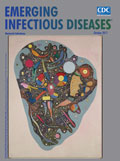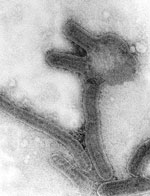
Volume 23, Number 10—October 2017
Etymologia
Etymologia: Marburg Virus
On This Page
In August and September 1967, an outbreak of a viral hemorrhagic fever occurred among laboratory workers in Marburg and Frankfurt, Germany, and Belgrade, Yugoslavia (now Serbia) who were processing kidneys from African green monkeys that had been imported from Uganda. (These kidneys were used in the production of polio vaccine.) Of 25 primary and 6 secondary cases, 7 were fatal.

Figure. Negative contrast electron microscopy of Marburg virus, from original monkey kidney cell culture propagation done at CDC in 1967, magnification ≈40,000x. Image courtesy of Frederick A. Murphy.
A new virus, named Marburg virus, was isolated from patients and monkeys, and the high case-fatality ratio called for the best biocontainment of the day (Figure). The Centers for Disease Control and Prevention (CDC) borrowed a mobile containment laboratory from the National Institutes of Health and set it up in the CDC parking lot; it provided approximately biosafety level 2+ containment. A few isolated, sporadic cases were reported in the following decades until a 1998 outbreak in the Democratic Republic of the Congo affected 154 people with a case-fatality ratio of 83%, and a 2004 outbreak in Angola affected 227 people with a case-fatality ratio of 90%.
References
- Siegert R, Shu HL, Slenczka W, Peters D, Müller G. [On the etiology of an unknown human infection originating from monkeys] [in German]. Dtsch Med Wochenschr. 1967;92:2341–3. DOIPubMed
- Kissling RE, Robinson RQ, Murphy FA, Whitfield SG. Agent of disease contracted from green monkeys. Science. 1968;160:888–90. DOIPubMed
- Kissling RE, Murphy FA, Henderson BE. Marburg virus. Ann N Y Acad Sci. 1970;174(2 Unusual Isola):932–45. DOIPubMed
- Centers for Disease Control and Prevention. About Marburg hemorrhagic fever [cited 2017 Mar 31]. https://www.cdc.gov/vhf/marburg/about.html





















.jpg)












No hay comentarios:
Publicar un comentario